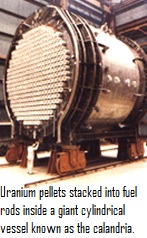| The generation of electricity through nuclear power plants in the United States cost 29.13 U.S. dollars per megawatt-hour in 2021. Production costs were highest in 2012, when they came to over 47.6 U.S. dollars in 2021 prices, but have decreased ever since. Some 780 terawatt-hours of electricity are generated by U.S. nuclear plants every year. |
- Some truths that we don't know and should be known.
How We Can Get Clean Energy ...
What Needs to Be Done? 
by Robert Zubrin
[First published in Quillette]
Nuclear power can provide unlimited safe energy for a magnificent human future. At one time it seemed like it would soon open the way to a revolution in human material circumstances. In the early 1970s, new nuclear power plants were being ordered in the United States at a rate of two per month. Had this been allowed to continue, the United States would have decarbonized its power grid by the 1990s—as France did, alone among major Western nations.
But the technological revolution nuclear power offers has, thus far, been strangled by political constraints, mismanagement, poor decisions, and outright sabotage. How can this situation be rectified?
Four areas need to be addressed. These include regulatory reform, waste disposal, support for research and development, and public understanding.
Let’s talk about each of them.
Regulatory reform
The most important thing that needs to be done to provide humanity with the benefits of nuclear power is regulatory reform. When antinuclear activists claim that nuclear power is a failure because it simply costs too much, they are lying. In fact, it is the activists themselves who have multiplied the costs of nuclear power by creating and exploiting a system of mendacious hyperregulation. They are like a poisoner on trial who claims that his victim died of heart failure. 
Relative to the energy it provides, the fuel for nuclear reactors is extremely cheap, comprising only about 5 percent of total power costs. It is plant financing and construction costs that dominate the cost of nuclear electricity. These costs are largely determined by the time it takes to complete a plant construction project which, in turn, is controlled by the regulatory process.
The insane nature of the process governing the building of a nuclear power plant is partially shown in the Nuclear Regulatory Commission’s (NRC’s) 32-step construction licensing process. I say “partially shown” because many of these steps require inputs drawn from similar multi-step processes undertaken by other local, state, and federal agencies, most notably the Environmental Protection Agency (EPA). Each of these hundreds of steps not only requires the participation of often slow-moving agencies involved but is also open to legal intervention by “the public,” that is, lawyers representing groups committed to stopping the plant. These lawyers capitalize on the numerous opportunities provided to them to both halt and vastly increase the cost of the process by throwing it into the courts.
The Nuclear Power Plant Licensing Process
For example, in order to get its construction license, the utility must first perform an Environmental Assessment for the NRC. This can take a year or so. Then, the NRC, using this data as a basis but requiring more, as well as the same data updated or in an alternative form, will draw up an Environmental Impact Statement (EIS) for evaluation by the EPA. By law, the NRC must write the EIS within two years. However, the NRC operates as if without constraint by law and actually takes an average of four years, sometimes as long as six, to write the EIS. The EPA, itself thoroughly infested with antinuclear activists, will then take its time evaluating the EIS and coming up with demands for more information. These will not only include matters nominally related to plant or public safety but also things entirely outside the purview of the EPA. For example, it is not uncommon for the EPA to demand a ...
[ Full text ]